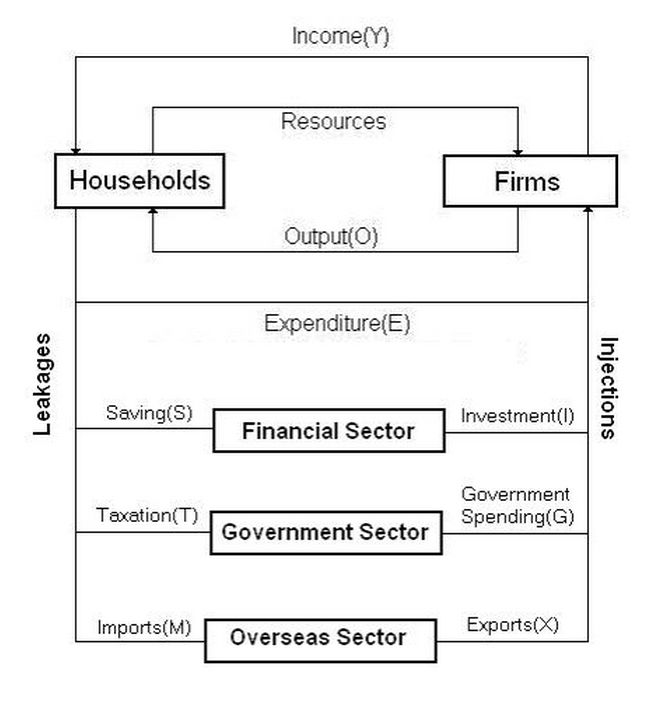-
Macroeconomic model that describes the flow of resources, goods and services, and income between the parts of the economy
-
The model divides the economy into its important sectors
- Households
- Firms
- The financial sector
- Government
- Overseas (foreign) sector
-
Shows that in any given time period, the value of output produced in an economy is equal to the total income generated in producing that output, which is equal to the expenditures made to purchase that output
-

-
Injections: inflows of money into the circular flow of income
-
Withdrawals: Outflows of money out of the circular flow of income
Components of the Circular Flow of Income
- These are the components that affect the CFY
- Saving(S)
- Investments(Pvt)(I)
- GovtExpenditure(G)andTaxation(T)
- Export revenue (X) and Import expenditure (M)
Injections vs Withdrawals
- Injections and withdrawals (leakages) provide us with an understanding of how the circular flow of Income is affected.
- Whether there is an increase in the flow or a decrease.
- Injections
- Inflows of money into the circular flow of income
- (increases the Circular flow of income)
- Injections = Investment (I) + Government Expenditure (G) + Exports (X)
- Withdrawals
- Outflows of money from the circular flow of income
- (decreases the Circular flow of income)
- Withdrawals = Savings (S) + Taxes (T) + Imports (M)
- An economy is in equilibrium when
- The rate of injections = the rate of withdrawals from the circular flow.
- Injections = Withdrawals
- (STM = IGX)
- Investment (I) + Government Expenditure (G) + Exports (X) = Savings (S) + Taxes (T) + Imports (M)
Circular Flow of Income
- The CFY model demonstrates an important principle: the income flow from firms to households is equal to the expenditure flow from households to firms.
- In other words, the household incomes coming from the sale of all the factors of production equals the expenditures by households on goods and services.
- This is the circular flow of income.
- In addition, these two flows must be equal to the value of goods and services, or the value of total output produced by the firms, known as the value of output flow.
The reasoning of this is as follows:
- If each good and service is multiplied by its respective price, we obtain the value of each good and service, and adding them all up we arrive at the value of total output.
- This value is the same as consumer expenditure, since spending by consumers is equal to each item they buy multiplied by its price.
Thus
The circular flow of income shows that in any given time period (say a year), the value of output produced in an economy is equal to the total income generated in producing that output, which is equal to the expenditures made to purchase that output.
- The Circular Flow model depicts the economy as a constantly circulating flow of real goods and services, and money.
- Statisticians and economists have developed national income accounting systems, based on the circular flow, to measure economic activity.